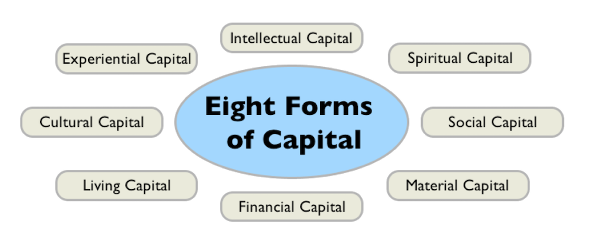Regenerative means…
Gaia University is rooted in Permaculture, an ethical design craft that advocates for re-integrating human societies with all other life. This means working at healing (regenerating) both human societies and the ecological systems in which they exist. In part, that’s what The New Economy is also seeking to do although voices of the New Economy frequently omit to mention their intentions regarding the ecosystems of the planet. It is common to hear of (and speak of), for example, social enterprises and social justice that perhaps imply an intention toward ecosystem health but not explicitly so.
The 3 ethics of permaculture (Earth Care, People Care and Living within Limits[1]) are ecocentric. This means that Earth Care precedes People Care (if the two are in conflict then assume that we need to work out how to ensure that Earth Care takes precedence – the logic being that, as human societies are dependant on healthy ecological systems, these ecosystems deserve the primary care). We have had very little practice at dealing with this kind of prioritization as yet but the need is ever increasing.
It follows that a regenerative livelihood (and we’ll explore the meaning of livelihood overleaf) has to be ecosocial (regenerating ecosystems AND socio-economic systems) and is one that works towards healing damaged ecosystems through creating living ‘capital’ whilst also assisting societies (and parts of societies such as communities, families and individuals) to change their orientation to one that actively supports the healing of our ecosystems.
Meanwhile more principles of regenerative enterprise design are being developed (and are draft and incomplete still) and we’ll publish more of these in later Elements.
The 8 Forms of Capital
The term ‘living capital’ is used in a model derived and elaborated by Gaia U Alumni, Ethan Roland (Soloviev) and Gregory Landua. During their time working on Financial Permaculture (right click) Ethan and Gregory extended the notion of capital to include living capital (soils, water, plants, forests, animals …).
They then exhort us to use any capital that we do have in abundance (intellectual capital perhaps) to get to work on enhancing the living capital of any ecosystems or parts of ecosystems that we have access to.
This is an important model that is finding widespread use amongst actionists seeking to create ecosocial change. We’d all do well to be familiar with this.
Here is the 8 Forms of Capital diagram:

Read a full description of the 8 Forms of Capital here.
For another definition of ‘regenerative’ (compatible with our own) click here.
[1] Living within limits – this third ethic is rewritten many times – some use ‘Fairshares’, Starhawk recently coined ‘Future Care’, early versions (1990’s) referred to the commitment of any surpluses towards Earth Care and People Care. Limits to consumption and population has also been used. Living within limits might also read as ‘thriving within limits’ as a way of indicating that ‘limits’ do not have to mean deprivation of any sort.